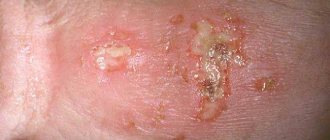Free consultation with a doctor by phone
Surgeon appointments are available daily by appointment!!!
LLC "Your Doctor"
Chat with the doctor
Addresses of medical centers in Moscow (unified reference) +7 (495) 255-45-59
Make an appointment at the clinic Discount on services Promotions
- +7 (495) 255-45-59
- Surgical centers in Moscow
- Every day from 9.00 to 20.00
- call me back
You can make an appointment with our operators by calling +7 (495) 255-45-59
Prices for services Clinic address Make an appointment Call a surgeon to your home Pediatric surgeon Ligation
A fibrous benign neoplasm, which occurs as a result of the closure of the outer lumen of the ducts of the sebaceous glands, is an atheroma on the penis. It looks like a round capsule of a yellowish color, it has clear boundaries. With atheroma on the penis, men experience complexes due to the unaesthetic appearance of the penis and psychological discomfort. Atheroma on the penis is not transmitted through sexual contact.
At the initial stage, atheroma is small in size and its growth takes quite a long time. If you ignore the presence and development of atheroma, the results can be disastrous. Atheroma on the penis can only be treated surgically or using a laser. It is advisable to remove it when the size of the atheroma is still small.
Useful information on the topic:
- Treatment of atheroma
- Ear atheroma
- Atheroma on the head
- Atheroma on the face
- Atheroma on the back
- Inflammation of atheroma
- Atheroma of the eyelids
- Purulent atheroma
- Breast atheroma
- Laser removal of atheroma
- Removal of atheroma at home
- Atheroma on the neck
- Atheroma on the lips
- Atheroma on the leg
- Atheroma in the groin
- Atheroma on the labia
Causes of white plaque
The causes of white plaque on the penis are classified into three groups:
- physiological. Associated with the peculiarities of the secretion of tyson glands located under the foreskin. The problem is aggravated by the lack of proper hygienic care of the genitals;
- non-infectious (endogenous). Caused by disruption of internal organs. Whitish accumulations on the penis are a concomitant symptom of chronic diseases or a sign of activation of opportunistic microorganisms that are part of the natural microflora of the body;
- infectious (exogenous). These are sexually transmitted diseases (STDs).
In the first case, it is enough for a man to get medical advice. To eliminate other causes, proper treatment is required.
Clinical manifestations
Cysts less than one centimeter almost always do not cause discomfort . An increasing atheroma makes itself felt by a noticeable dense tubercle that does not cause pain upon palpation. In the absence of an inflammatory process, the skin over the defect is smooth.
If an infection has entered the wen, the patient begins to suffer from severe itching, mild pain, redness of the epithelium around the formation, and increased temperature of the affected area.
Lack of timely treatment leads to significant swelling of tissue structures, severe pain, and hyperemia. At the same time, pathogenic microorganisms also infect other organs of the reproductive system.
The process of suppuration is dangerous due to the formation of an abscess. If the lipoma progresses well, it can open on its own, releasing a capsule with its contents.
White coating on the penis: when is this normal?
Why might a white coating on the penis be normal? Due to the increased production of a special male secretion - smegma. It is produced by tyson (preputial) glands under the foreskin - a type of exocrine sebaceous glands. Smegma facilitates the sliding of the foreskin when exposing the head of the penis. The secretion mixes with exfoliated epithelial cells, forming a white coating on the head of the penis. The problem is more common in men who have not undergone circumcision. Increased secretion of the preputial glands does not require special treatment. But if the rules of hygiene of the genital organs are not followed, it can lead to inflammation (balanitis, balanoposthitis) and oncopathology.
Treatment and removal of sebaceous glands on the penis
There are no effective conservative methods for treating enlarged sebaceous glands. You can only get rid of it by mechanical removal. After 40 years, the pace of their work slows down, the granules will become less pronounced.
Do they need to be removed: if the glands do not become inflamed or transformed, then there is no need to treat. However, some men experience psychological and physical discomfort from their presence and consult a doctor for removal.
Doctor's opinion from the site https://sprosivracha.com/questions/266455-salnye-zhelezy-na-golovoke-i-kozhe-chlena:
From the site https://03uro.ru/consultations/question/20330:
Laser and radio wave radiation are used to remove sebaceous glands on the penis. Both methods are effective and low-traumatic, but radio wave is technically more advanced and healing occurs faster. Manipulations are performed under local anesthesia. As an anesthetic, apply Emla cream for 10-15 minutes. First, it is advisable to remove 5-10 pieces, so that after 2 weeks the patient can evaluate the result. If he is satisfied with the aesthetic appearance, then the rest are removed.
Some glands do not completely evaporate, but in this case the main thing for the doctor is not to create scars. It’s better to clean up the remaining formations later.
Dermatovenerologist Evgeniy Aleksandrovich Volokhov talks about methods for removing the sebaceous glands of the penis
Consequences of removal by radio wave method - https://prntscr.com/vqdiuz.
For several days you will need to treat the skin of the penis with peroxide, chlorhexidine and smear it with Levomekol. The crusts will soon fall off. After 1-2 months, only whitish spots will remain in their place. You can't have sex for about a month until the skin is completely restored. To prevent the appearance of scars, doctors recommend smearing the penis with absorbable ointments such as Contractubex after healing.
Levomekol has anti-inflammatory and antimicrobial effects. Price in pharmacies from 126 rubles
Squeezing out the glands on your own is dangerous and useless. Fat will quickly accumulate again, and inflammation will occur at the site of the squeezed out granule, followed by scarring. Lubricating with fir oil, mumiyo, garlic juice and other folk methods do not help.
Cosmetic defects in the form of Fordyce granules tend to reappear after several years or even months. As confirmation, here is a screenshot of the doctor’s response from the forum https://forum.ykt.ru/viewtopic.jsp?id=4493410:
White plaque on the penis: possible diseases
White plaque on the penis accompanies balanitis, provoked by an exacerbation of psoriasis. Skin pathology has no clear cause and is considered irreversible. When relapsed, psoriatic plaques can affect the genitals, causing inflammation.
White plaque on the penis and itching of the genitals are not uncommon with diabetes. The disease is characterized by metabolic disorders, failure of the production of the hormone insulin or insulin resistance. A diabetic's urine contains glucose, which irritates the head of the penis when urinating. As a result, balanoposthitis develops.
Curdled discharge on the penis occurs due to candidiasis (thrush) of non-infectious origin - increased activity of fungi of the genus Candida. Disturbance of microflora balance occurs against the background of:
- weakened immune status;
- prolonged psycho-emotional overload;
- incorrect antibiotic therapy;
- intoxication (including alcohol);
- systematic contact of the genitals with synthetic fabrics;
- unbalanced diet;
- failure of metabolic processes.
Candidiasis is transmitted sexually if a woman has progressive thrush.
A separate category consists of sexually transmitted diseases. Infection occurs through unprotected intimate contact with an infected partner. Redness of the penis and a white coating are among the symptoms of most sexually transmitted infections.
STDs and pathogens
| bacteria | |
| syphilis | treponema pallidum |
| gardnerellosis (in men) | gardnerella |
| gonorrhea | gonococci |
| ureplasmosis | ureplasma |
| viruses | |
| papillomatosis | human papillomavirus |
| cytomegalovirus infection (CMVI) | cytomegalovirus |
| genital herpes | herpes virus type 2 |
| prokaryotes | |
| mycoplasmosis | mycoplasma |
| protozoan parasites | |
| chlamydia | chlamydia |
| trichomoniasis | trichomonas |
Diagnostics
A penile cyst is easily diagnosed, without the use of hardware and laboratory research methods. An experienced specialist is able to establish an accurate diagnosis even during an external examination of the affected organ.
Cyst surgery on the coccyx
Surgery to remove a coccyx cyst is the most effective way to get rid of the disease.
In this case, the doctor is obliged to exclude diseases that are similar in symptoms, for example, Peyronie’s disease with dense scars on the skin of the penis, lymphangitis with chronic inflammatory damage to the lymph nodes, smegmolitis with a pathological process in the head and foreskin due to deterioration of the outflow of secretions, allergic reactions, benign sebaceous gland adenoma .
Lipoma can recur, so it is important to identify the true cause, the provoking factor for the development of the wen.
Diagnosis and treatment
Treatment of diseases of the male reproductive system, including treatment of STDs, is the responsibility of urologists and andrologists. In case of an infectious lesion, therapy is prescribed by a venereologist. The cause of plaque on the penis is diagnosed based on the results:
- visual medical examination;
- studying the patient's premorbid background;
- laboratory tests: OCA and blood biochemistry, urethral smear, urine test;
- ultrasound examination of the pelvic organs.
Based on the results of the examination, the doctor chooses treatment tactics, determines medications, dosage and duration of the therapeutic course. For bacterial, prokaryotic, and parasitic infections, antibiotics are prescribed. Candidiasis is treated with antimycotics in tablets and ointments. For diabetes and psoriasis, basic treatment and diet therapy are adjusted.
Preventive measures help prevent unpleasant manifestations - careful genital hygiene, barrier contraception, strengthening the immune system and following the recommendations of the attending physician (for chronic diseases).
An important point is a timely visit to a urologist, both in the event of symptomatic complaints and for prevention. Make an appointment
Main methods of treatment
If a cyst of any color or size is detected, you should contact a specialist. A urologist-andrologist will determine the cause of the disorder and draw up a treatment plan. There are three main methods:
- surgical excision;
- laser or radio wave removal;
- cryodestruction.
The appropriate method is selected individually. The choice depends on the type of neoplasm, concomitant and previous diseases. Cyst removal is performed on an outpatient basis using local anesthetics. You must first make an appointment with a urologist.
To get an appointment with a doctor, call the reception desk. We will select a time convenient for you. The prices for the clinic’s services can be found in the price list.
Possible complications
Self-treatment is contraindicated, because in rare cases a cyst leads to serious consequences, such as:
- Abscess.
- Phlegmon.
- Penetration of pathogenic microorganisms into the lipoma cavity.
- Infection of neighboring tissues.
- Repeated accumulation of purulent contents after its elimination at home.
- Penetration of pus into the tissue under the skin.
Some of the complications can cause significant harm to the sexual organ and the entire body, so you should not self-medicate.
Treatment methods
Atheroma is a non-lethal disease that rarely worsens the general condition of the body. If the formations are small in size, there are no unpleasant sensations, or an inflammatory process, only periodic observation by a specialist is required without surgical intervention.
If redness appears and purulent contents begin to be released, the cyst should be removed immediately. In this case, elimination of the pathological formation does not require hospitalization. The gland duct is drained, followed by curettage of the capsule.
Why can our articles be trusted?
We make health information clear, accessible and relevant.
- All articles are checked by practicing doctors.
- We take scientific literature and the latest research as a basis.
- We publish detailed articles that answer all questions.
The classic operation is performed under local anesthesia. During standard surgery, the capsule is opened to allow free release of purulent contents. After this, the cavity is treated with an antiseptic solution, and the body of the cyst is removed.
The rehabilitation period consists of treating the wound with special ointments and antiseptics. Antibiotics are not prescribed in this case.
If the atheroma is not inflamed, but causes only cosmetic discomfort, then electrical destruction or radio wave method is used to eliminate the problem. These two modern methods of getting rid of a wen on the penis are indicated only for small lesions and are done under local anesthesia.
Forecast
The prognosis for wen of the genital organ is very favorable. If the atheroma is small, not inflamed, and does not cause discomfort, then removal of the formation is not carried out. Instead, the patient should be periodically examined by an experienced specialist to evaluate the pathology.
If there is an inflammatory process, discharge of purulent contents, or pain, the lipoma should be removed immediately, otherwise infection and the development of an abscess are possible. In severe and advanced cases, even amputation of the organ is possible, so you should not engage in independent treatment or squeeze out the purulent contents.
A cyst on the penis is a common condition that most often occurs in adolescence or middle age. In young men, lipoma appears due to hormonal disorders and increased testosterone production. This occurs during puberty.
When this period ends, the atheroma often resolves on its own. In other cases, the occurrence of a neoplasm in the intimate area indicates a blockage of the duct of one of the sebaceous glands or mechanical damage to the delicate epithelium during shaving with a razor.
To prevent clogging, it is necessary to observe the rules of personal hygiene and avoid the use of ordinary soap. Instead, wash the penis and scrotum with special gels. If a cyst appears, you must consult a doctor promptly, without waiting for alarm signals.
Causes
Doctors are confident that atheroma can occur in men against the background of complete health due to:
- Natural synthesis of testosterone - the male hormone.
- Excessive sweating in the groin area.
- Wearing tight underwear or clothes that fit tightly to the body.
- Injuries to the sebaceous gland, a similar situation can occur among piercing fans.
- Insufficient basic hygiene.
Most often, it is not possible to identify the main factor that caused a cyst on the penis.











